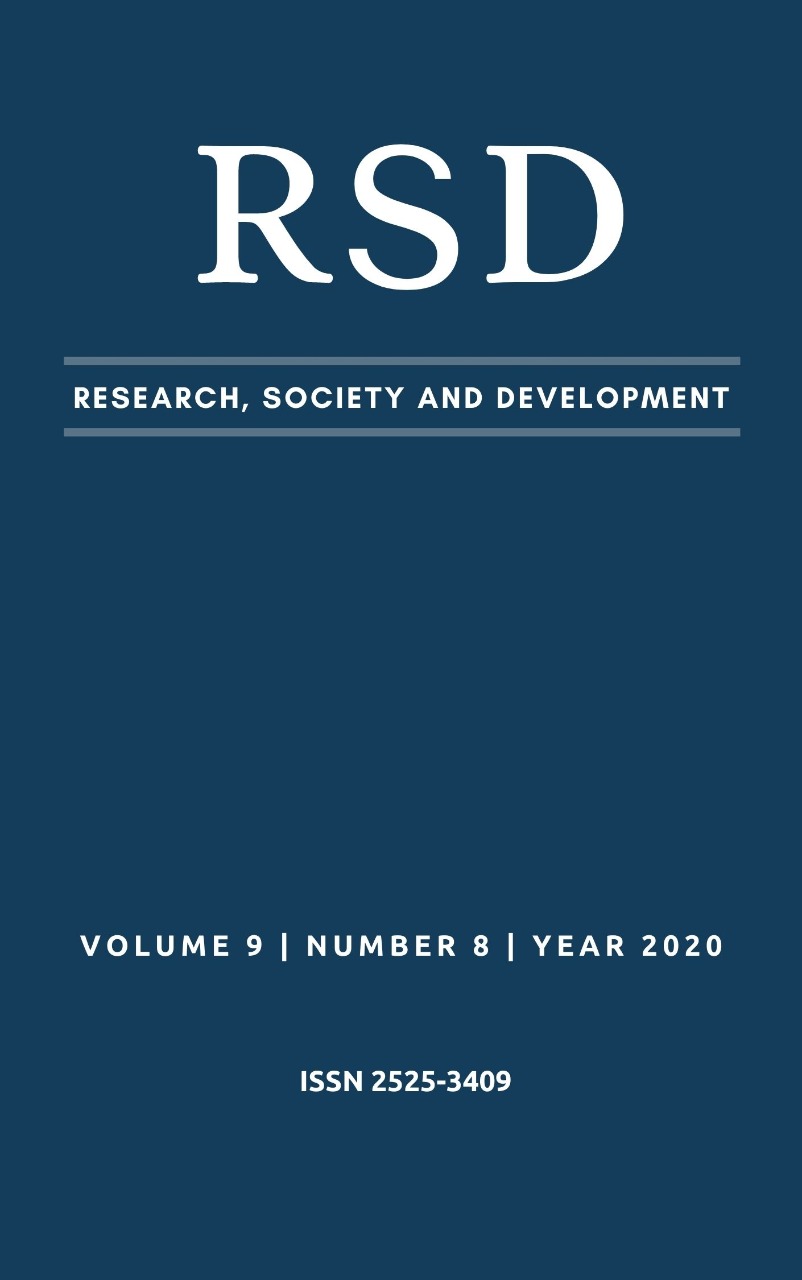Perfil bacteriológico e variáveis da ferida neoplásica em pacientes em cuidados paliativos: estudo transversal
DOI:
https://doi.org/10.33448/rsd-v9i8.5460Palavras-chave:
Ferimentos e Lesões, Cuidados Paliativos, Enfermagem Oncológica.Resumo
Objetivo: verificar a associação entre perfil bacteriológico e variáveis relacionadas às feridas neoplásicas dos pacientes sob cuidados paliativos. Método: Estudo transversal, com amostra composta por 36 pacientes internados nas enfermarias do Instituto Nacional do Câncer José Alencar Gomes da Silva – Unidade IV. A coleta de dados ocorreu entre os meses de outubro e dezembro de 2018, sendo utilizado um formulário próprio. Na análise dos dados utilizaram-se medidas descritivas e teste de Fischer/qui-quadrado ao nível de significância de 5% (α = 0,05). Resultados: A amostra foi composta por 36 indivíduos, sendo 19 (52,78%) do sexo feminino, com percentual predominante de formação de metástases (63,89%). Há forte associação entre as variáveis radioterapia paliativa e a presença de Pseudomonas sp. (p = 0,02), tipo de tumor primário e a presença de Citrobacter sp. e Acinetobacter sp. (p < 0,001) e localização da ferida neoplásica a presença de Citrobacter sp. (p = 0,03) e Acinetobacter sp. (p = 0,01). A não utilização de antibiótico não favorece o aumento do biofilme na ferida neoplásica. A quimioterapia paliativa não se associa a nenhum gênero bacteriano. As principais bactérias identificadas foram Pseudômonas sp., Morganella sp., Klebsiella sp. e Proteus sp.. Conclusão: o tratamento com radioterapia, o tipo de tumor primário e local da ferida tumoral apresentam associação significativa com o perfil bacteriológico das lesões e, portanto, recomenda-se a coleta de swab e análise de antibiograma das feridas neoplásicas para aprimorar a assistência de enfermagem.
Referências
Agra, G., Fernandes, M. A., Platel, I. C. dos S., & Freire, M. E. M. (2013). Cuidados Paliativos ao Paciente Portador de Ferida Neoplásica: uma Revisão Integrativa da Literatura Palliative Care for the Patient with Neoplastic Wound: an Integrative Literature Review. Revista Brasileira de Cancerologia, 59(1), 95–104. http://www1.inca.gov.br/rbc/n_59/v01/pdf/16-cuidados-paliativos-ao-paciente-portador-de-ferida-neoplasica.pdf
Beretta, L., Santos, M., Santos, W., Fuly, P. S. C., & Berardinelli, L. (2020). Resiliência no processo do cuidado aos pacientes com feridas tumorais malignas: revisão integrativa. Research, Society and Development, 9(4), e117942922. https://doi.org/http://dx.doi.org/10.33448/rsd-v9i4.2922)
Brito, D., Agra, G., & Costa, M. (2017). Cuidados Paliativos a Pacientes com Ferida Neoplásica: Uma Perspectiva para a Assistência de Enfermagem Cuidados Paliativos a Pacientes com Ferida Neoplásica: Uma Perspectiva para a Assistência Autores. Journal of Aging and Innovation, 6(3), 28–38.
Castro, D. L. V., & Santos, V. L. C. de G. (2015). Controlling wound odor with metronidazole: A systematic review. Revista da Escola de Enfermagem da USP, 49(5), 858–863. https://doi.org/10.1590/S0080-623420150000500021
Castro, M. C. F., Santos, W. A., Fuly, P. dos S. C., Santos, M. L. S. C., & Garcia, T. R. (2017). Intervenções de enfermagem para pacientes oncológicos com odor fétido em ferida tumoral. Aquichan, 17(3), 243–256. https://doi.org/10.5294/aqui.2017.17.3.2
Draper, C. (2005). The management of malodour and exudate in fungating wounds. British Journal of Nursing, 14(11). https://doi.org/10.12968/bjon.2005.14.sup2.18210
Fromantin, I., Seyer, D., Watson, S., Rollot, F., Elard, J., Escande, M. C., De Rycke, Y., Kriegel, I., & Garde, V. L. (2013). Bacterial floras and biofilms of malignant wounds associated with breast cancers. Journal of Clinical Microbiology, 51(10), 3368–3373. https://doi.org/10.1128/JCM.01277-13
Gericher, U. (2008). Acinetobacter Molecular Biology. Caister Academic Press
Gozzo, T. de O., Tahan, F. P., Andrade, M. de, Nascimento, T. G. do, & Prado, M. A. S. (2014). Occurrence and management of neoplastic wounds in women with advanced breast cancer. Escola Anna Nery - Revista de Enfermagem, 18(2), 270–276. https://doi.org/10.5935/1414-8145.20140039
Instituto Nacional de Câncer José Alencar Gomes da Silva. (2019). Estimativa 2020: incidência de câncer no Brasil.
Instituto Nacional de Câncer. (2011). Tratamento e controle de feridas tumorais e úlceras por pressão no câncer avançado. INCA.
http://bvsms.saude.gov.br/bvs/publicacoes/inca/Feridas_Tumorais.pdf
Lisboa, I. N. D., & Valença, M. P. (2016). Caracterização de pacientes com feridas neoplásicas. Estima, 14(1), 21–28. https://doi.org/10.5327/z1806-3144201600010004
Lund-Nielsen, B., Adamsen, L., Gottrup, F., Rorth, M., Tolver, A., & Jorn Kolmos, H. (2011). Qualitative bacteriology in malignant wounds - A prospective, randomized, clinical study to compare the effect of honey and silver dressingsi. Ostomy Wound Management, 57(7), 28–36.
Matsubara, M. (2015). Feridas e estomas em oncologia: uma abordagem interdisciplinar. Lemar.
Silva, V., Marcoleta, A., Silva, V., Flores, D., Aparicio, T., Aburto, I., Latrach, C., & Febré, N. (2018). Prevalencia y perfil de susceptibilidad antimicrobiana en bacterias aisladas de úlceras crónicas infectadas en adultos. Revista Chilena de Infectología, 35(2), 155–162. https://doi.org/10.4067/s0716-10182018000200155
Watanabe, K., Shimo, A., Tsugawa, K., Tokuda, Y., Yamauchi, H., Miyai, E., Takemura, K., Ikoma, A., & Nakamura, S. (2016). Safe and effective deodorization of malodorous fungating tumors using topical metronidazole 0.75 % gel (GK567): a multicenter, open-label, phase III study (RDT.07.SRE.27013). Supportive Care in Cancer, 24(6), 2583–2590. https://doi.org/10.1007/s00520-015-3067-0
Downloads
Publicado
Edição
Seção
Licença
Autores que publicam nesta revista concordam com os seguintes termos:
1) Autores mantém os direitos autorais e concedem à revista o direito de primeira publicação, com o trabalho simultaneamente licenciado sob a Licença Creative Commons Attribution que permite o compartilhamento do trabalho com reconhecimento da autoria e publicação inicial nesta revista.
2) Autores têm autorização para assumir contratos adicionais separadamente, para distribuição não-exclusiva da versão do trabalho publicada nesta revista (ex.: publicar em repositório institucional ou como capítulo de livro), com reconhecimento de autoria e publicação inicial nesta revista.
3) Autores têm permissão e são estimulados a publicar e distribuir seu trabalho online (ex.: em repositórios institucionais ou na sua página pessoal) a qualquer ponto antes ou durante o processo editorial, já que isso pode gerar alterações produtivas, bem como aumentar o impacto e a citação do trabalho publicado.


